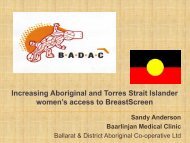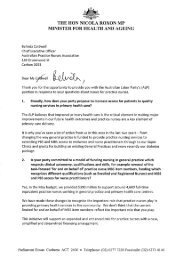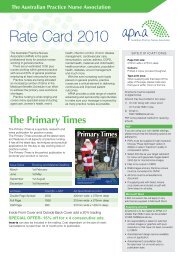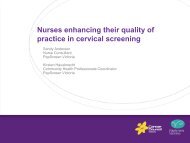Patient treatment report user guide - Department of Veterans' Affairs
Patient treatment report user guide - Department of Veterans' Affairs
Patient treatment report user guide - Department of Veterans' Affairs
Create successful ePaper yourself
Turn your PDF publications into a flip-book with our unique Google optimized e-Paper software.
Reading the <strong>Patient</strong> Treatment Report345<strong>Patient</strong> <strong>treatment</strong> <strong>report</strong> as at 31/07/2011 <strong>Patient</strong>: JOHN SAMPLEDR A SAMPLE 1 DVA Identifier: XXXXXXAge: 85Gender:M2 Admission Risk Rank: 84Chronic and other high risk conditionsClaims data indicate that your patient has the following conditions:CVC targeted chronic conditionsCADOther high risk conditionsCancerServices received in the previous 12 monthsWhere applicable, further information on recent hospitalisations and medications is included in the attached history.Overnight Same Day Specialist GP VHC CN AHP Total FilledAdmissions Admissions Visits Visits 6 Hours Visits Visits Medications0 0 1 27 0 0 12 16<strong>Patient</strong> history <strong>report</strong> for the past 6 monthsOvernight Admissions Discharge Diagnosis Code and Description Procedure Code and DescriptionNone7Allied Health Pr<strong>of</strong>essionals (AHP) history for the past 3 monthsType <strong>of</strong> Allied Health Pr<strong>of</strong>essional Number <strong>of</strong> visits Last visitDiabetes Educators 1 23/08/2011Exercise Physiologists 4 13/07/2011Orthotists 2 02/07/2011Osteopathic 1 01/07/2011Medication history for the past 3 monthsMedication Strength No. Filled Date Last FilledBETAMETHASONE DIPROPIONATE Cream 500 micrograms (base) per g (0.05%), 15 g 6 23/05/2011CEPHALEXIN Capsule 500 mg 4 4/06/2011v SODIUM Tablet 20 mg 7 19/05/20118Clinical pathways opportunitiesClinical care and judgment is necessary in all matters, the following opportunities are intended as a <strong>guide</strong> only.Test/Treatment Received Condition Test / Treatment Date <strong>of</strong> service <strong>of</strong> most recent claimYes CAD Lipid regulator medication 2/06/2011Yes CAD Beta blocker medication 5/05/2011Yes CAD Cholesterol test 17/01/20116 months <strong>of</strong> history included for medication opportunities and 12 months <strong>of</strong> history for test/<strong>treatment</strong> opportunities.9This <strong>report</strong> has been sent by Bupa Health Dialog on behalf <strong>of</strong> theCoordinated Veterans’ Care Program, a <strong>Department</strong> <strong>of</strong> Veterans’ <strong>Affairs</strong> initiative.Please treat in accordance with Commonwealth and local privacy laws.www.dva.gov.au/cvc.htm2
<strong>Patient</strong> Treatment ReportUser GuideAllied Health Pr<strong>of</strong>essionals (AHP)history for the past 3 monthsThis highlights the number <strong>of</strong> visits to AHPsin the last 3 months along with the date <strong>of</strong>most recent service. Each AHP type willappear on a separate line. The followingAHPs will be included:• Chiropractic• Dental• Diabetes Educators• Dietetics• Exercise Physiologists• Occupational Therapy• Optical• Orthotists• Osteopathic• Physiotherapy• Podiatry• Psychology• Social Work• Speech PathologyMedication history for the past3 monthsThe medication table describes the name <strong>of</strong>the medication (drug name), strength andhow many times the medication has beenfilled in the last 3 months, as available toDVA. The date provided is the ‘Date LastFilled’ and identifies the most recent fill datefor each medication-strength combination.If the strength <strong>of</strong> a given medicationchanges, this will appear as a new line.Clinical Pathways OpportunitiesClinical pathways opportunities representthe tests and <strong>treatment</strong> regimes for eachpatient’s chronic condition/s. It is for you,the GP, to decide if the <strong>treatment</strong>s listedare appropriate for your patient/s andthe table should be viewed as suggestedopportunities only.In the development <strong>of</strong> the PTR, DVA hasreferenced <strong>guide</strong>lines established by therelevant national bodies in Australia toidentify certain elements <strong>of</strong> clinical care thatmight be identified by a DVA payment. Whereno payments <strong>of</strong> these types have been madeby the DVA, it is for you, the GP to decideif the <strong>treatment</strong>s listed are appropriatefor your patient/s and the table should beviewed as suggested opportunities only.The <strong>guide</strong>lines used are listed below:Coronary Artery DiseaseNational Heart Foundation and the CardiacSociety <strong>of</strong> Australia and New Zealand.Reducing the risk <strong>of</strong> heart disease 2007(updated 2008).Retrieved October 2011, from http://www.heartfoundation.org.au/SiteCollectionDocuments/Reduce-risk-inheart-disease-<strong>guide</strong>line.pdf6
Congestive Heart FailureNational Heart Foundation <strong>of</strong> Australia andthe Cardiac Society <strong>of</strong> Australia and NewZealand (Chronic Heart Failure GuidelinesExpert Writing Panel) (2011, October).Guidelines for the prevention, detection andmanagement <strong>of</strong> Chronic Heart Failurein Australia.Retrieved October 2011, from http://www.heartfoundation.org.au/SiteCollectionDocuments/Chronic_Heart_Failure_Guidelines_2011.pdfDiabetesRoyal Australian College <strong>of</strong> GeneralPractitioners and Diabetes Australia.Diabetes management in general practiceSeventeenth edition 2011/12 Guidelines forType 2 diabetes.Retrieved October 2011, from http://www.racgp.org.au/Content/NavigationMenu/ClinicalResources/RACGPGuidelines/Diabetesmanagement/201107diabetesmanagementingeneralpractice.pdfChronic Obstructive Pulmonary DiseaseThe Australian Lung Foundation andthe Thoracic Society <strong>of</strong> Australia andNew Zealand.Australian and New Zealand Guidelines for themanagement <strong>of</strong> chronic obstructive pulmonarydisease 2011.Retrieved October 2011, fromhttp://www.copdx.org.au/executive-summaryAccording to the claims paid by the DVA todate, the test/<strong>treatment</strong> column indicatesif the patient has received (yes) or has notreceived (no) the tests and/or <strong>treatment</strong>sas outlined in the <strong>guide</strong>lines for eachcondition. Note: some tests and/or<strong>treatment</strong>s may not be included if claimshave not been paid by DVA. This is limitedto the following conditions:• Diabetes• Congestive Heart Failure• Coronary Artery Disease• Chronic Obstructive Pulmonary Disease.The condition field outlines the specificdisease that the tests and <strong>treatment</strong>s arerelevant for.The most recent claim date representswhen the test or <strong>treatment</strong> was lastconducted or received.7
Frequently AskedQuestionsDoes the <strong>Patient</strong> Treatment Report includeall <strong>of</strong> my patients?The <strong>Patient</strong> Treatment Report (PTR) onlyincludes information on those patientsthat you have currently enrolled on theCVC Program. Should you enrol any newpatients on the program, you will receivesubsequent PTRs for them in the quarterfollowing their enrolment.Why has the <strong>Patient</strong> Treatment Report beensent to me?You have received the PTR because you havea patient or patients enrolled on the CVCProgram. The PTR is a practice support toolfor GPs.Who produces the <strong>Patient</strong>Treatment Report?The PTR is produced by Bupa HealthDialog on behalf <strong>of</strong> the CoordinatedVeterans’ Care Program, a <strong>Department</strong> <strong>of</strong>Veterans’ <strong>Affairs</strong> initiative.Will I always receive hard copies <strong>of</strong>the <strong>report</strong>?Each time you enrol a new veteran on theCVC Program, you will receive the firstquarterly <strong>report</strong> in hard copy format. Future<strong>report</strong>s are planned for online delivery.How is the data in the <strong>report</strong> sourced?The PTR is sourced from claims data, asheld by DVA.• Hospital – includes public andprivate hospitals• Medical – includes claims from GP visits,specialist visits, and other medical servicesreceived during a hospital admission8• Prostheses – includes claims associatedwith prosthetics, human tissue andassociated materials used during ahospital admission• Ancillary – includes claims associated withallied health pr<strong>of</strong>essionals, dental, opticaland associated services• DVA specific – including services providedspecifically for veterans, includingcommunity nursing services and Veterans’Home Care services• Pharmacy – including medications thepatient is currently on.Can I give the <strong>report</strong> to my patients?The PTR is intended to be a tool for you, asthe GP, to use to support you in deliveringcare to patients with chronic illness, and assuch contains sensitive patient informationand is confidential. The information containedin the PTR may only be used or disclosed forthe purposes <strong>of</strong> the CVC Program. The PTRmust be handled confidentially and strictly inaccordance with the Privacy Act 1988 (Cth),and any health records legislation that maybe applicable in your State or Territory. ThePTR remains the property <strong>of</strong> the <strong>Department</strong><strong>of</strong> Veterans’ <strong>Affairs</strong>.Who can I contact for more information andgive feedback?For more information and give feedback onthe <strong>Patient</strong> Treatment Report please contactthe CVC Provider Helpline:• Call 1300 550 597• Email: info@cvchelpline.net.auWhere can I find more information?Call 1300 550 597Email info@cvchelpline.net.auVisit www.dva.gov.au/cvc.htm
For more information:Call 1300 550 597Email info@cvchelpline.net.auVisit www.dva.gov.au/cvc.htmThe Coordinated Veterans’Care Program is a <strong>Department</strong><strong>of</strong> Veterans’ <strong>Affairs</strong> initiative,supported by primary serviceprovider, Bupa Health Dialog.ADVA_PTR_V1.2_120131
















